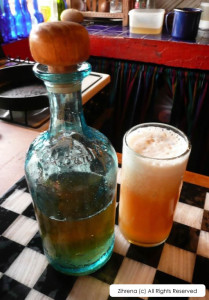Cantaloupes are plentiful right now in the Zihuatanejo market and supermarkets, and they are especially sweet at the moment. It’s worth running down to the Mercado Central to pick some up, and here’s a perfect way to use them to cool down in the heat of early summer.

Ginger Zing
This refreshing juice combination was the inspiration of Leah, my cousin (once-removed) when she started experimenting with her new Omega juicer. I find it’s easier just to whip this up in a blender or Vitamix than do the juicing routine, though, since there’s so little pulp to remove.
Cantaloupe-Ginger Zing
1/2 cantaloupe
1/4 cup ginger juice (see below)
2 cups water
Remove the rind from the cantaloupe, chop up the rest and throw it into your blender or Vitamix (yes, that means the seeds and gunky stuff around the seeds as well–that’s where most of the taste and the nutrition are). Add the ginger juice and water. Blend until the cantaloupe meat is liquefied. This doesn’t take long, especially in the Vitamix. Thirty seconds, maybe a bit more?
Strain the resulting juice through a sieve or nut milk bag. Toss the small amount of pulp and seed residues into the compost, then toss a couple of ice cubes into your juice and enjoy.
Ginger Juice
I regularly whip up a strong ginger tea by slicing a fresh ginger root (pared, scoured or scraped to remove the thin skin) and simmering it, covered, in 2-3 cups of water for about an hour. Then I usually let it cool overnight, which allows it to steep even more. Strain and store. Some people like to sweeten it before storing, but I prefer to sweeten it just before using it–the sweetness will depend on what I’m using it for. It’s a good base for homemade ginger ale, or to use in oriental sauces or dressings, or to combine with other herbal teas for hot or cold drinks.
Cantaloupe The cantaloupe originated in India and Africa. Cantaloupes were originally cultivated by the Egyptians and later the Greeks and Romans. Cantaloupes were first introduced to North America by Christopher Columbus on his second voyage to the New World in 1494. The W. Atlee Burpee Company developed and introduced the “Netted Gem” in 1881 from varieties then growing in North America. (Wikipedia contributors, “Cantaloupe,” Wikipedia, The Free Encyclopedia, http://en.wikipedia.org/w/index.php?title=Cantaloupe&oldid=433477330 [accessed June 12, 2011].) Ginger Mature ginger roots are fibrous and nearly dry. The juice from old ginger roots is extremely potent [11] and is often used as a spice in Indian recipes, and is a quintessential ingredient of Chinese, Japanese and many South Asian cuisines for flavoring dishes such as seafood or goat meat and vegetarian cuisine. Ginger acts as a useful food preservative. (Wikipedia contributors, “Ginger,” Wikipedia, The Free Encyclopedia, http://en.wikipedia.org/w/index.php?title=Ginger&oldid=433795817 [accessed June 12, 2011].)